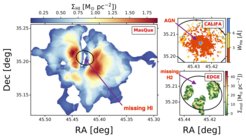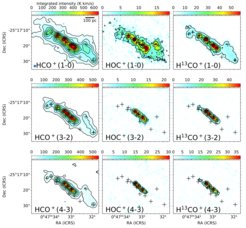Nearby Galaxies
Studies of the interstellar medium provide key information about the physical and chemical processes which drive the evolution of galaxies. Observations in the sub-millimeter wavelength regime, as provided by APEX, Herschel ALMA and NOEMA, are in particular critical as they trace the cold gas reservoir - the material from which new generations of stars are born. The relations between the chemical and physical properties of the cold molecular gas and star formation are key research areas of our group. In the coldest phase, the interstellar medium is mainly molecular. Observations of molecular emission lines and radiation from dust grains allow us to measure the gas kinematics, cooling balance and chemical composition of the molecular clouds. The environment in which cold clouds reside largely affects their capabilities to form stars. Observations of nearby galaxies probe the full scale of conditions met in the local universe and therefore provide important clues to interpret the star formation and galaxy evolution in the early universe.
The Apex Magellanic Cloud Legacy Survey

In the local universe star formation is exclusively associated with molecular clouds. Understanding the efficiency of this process, the environmental conditions under which star formation occurs and the impact of feedback from newly formed massive stars on this process is a crucial goal of modern astrophysics.
Numerical simulations and theory have consistently shown that the interstellar medium should be highly filamentary and that star formation is intimately related to self-gravitating filaments. These structures can be identified in large scale surveys in the MW, but in nearby galaxies the spatial resolution of molecular cloud studies is typically too poor to allow resolving the relevant spatial scales even with ALMA.
With their proximity of only 50 kpc, our nearest neighbours - the Large and Small Magellanic Clouds - offer a unique laboratory to study the star formation process in cold, dense molecular clumps and filaments. Even with the APEX telescope we are able to study the gas at a high spatial resolution of 4 pc.
The MPIfR with its international partners is currently conducting the Apex Magellanic Cloud Legacy Survey to map the distribution of the dense molecular gas in the CO(3-2) and 13CO(3-2) emission lines using the 345-GHz LASMA 7-pixel array receiver at APEX. The survey has a total areal coverage of 15deg2 and will cover all main dust complexes in the Large and Small Magellanic Clouds down to a molecular mass completeness limit of 300 Msol.
Evolution and star formation quenching of nearby galaxies

The evolution of galaxies is largely driven not only by how stars form, but also by the way in which star formation ends. The “star formation quenching'', that accompanies the transformation of a blue spiral into a red elliptical galaxy, can be caused by a variety of phenomena connected to removal, reduction, or stabilisation of the star formation raw fuel: the cold gas.
In the context of the CALIFA survey (which observed a sample of ~1000 galaxies with an optical IFU), we are involved in a series of large observational programs to study the properties and the distribution of the molecular and atomic gases within galaxies at different phases of their evolution. These programs involve several telescopes such as APEX, CARMA, NOEMA, ACA, GBT (the EDGE project), and Effelsberg, VLA, GMRT (the MasQue project) and will provide an unprecedented dataset to unveil the evolution of galaxies in the nearby Universe.
Using this data, we have shown that galaxies quench their star formation following specific patterns, but AGNs (which are considered to be one of the main star formation quenching agents) do not seem to significantly alter the galaxy's global properties. Nevertheless, regions surrounding the AGNs appear to have smaller contents of molecular and atomic gas compared to the rest of the disc. On a global scale, we have demonstrated that the retirement of galaxies is mostly regulated by how they convert the gas into stars (the so-called star formation efficiency) rather than by the absence of gas. Galactic large-scale dynamics (such as circular speed and shear) and secular evolution (driven by spiral arm, bar, and bulge interactions) appear to play a big role in modifying the star formation efficiency in different regions of the galaxies.
Links to Projects:
The ALCHEMI survey

The large program ALCHEMI used ALMA to image the Central Molecular Zone (CMZ) of the iconic starburst galaxy NGC253 in a nearly contiguous 289 GHz frequency range between 84 and 373 GHz, with a 1.6" angular resolution (28 pc) and a sensitivity of 30-50 mK.
Results already published from this unprecedented high-resolution and high-sensitivity extragalactic project are the first extragalactic detections of some Complex Organic Molecules (COMs), such as C2H5OH, HOCN, and HC3HO, newly detected vibrationally excited lines of HCN, HNC and HC3N originating in the hot cores of star-forming Giant Molecular Clouds (GMCs) (Martin et al. 2021), the starburst energy feedback measured by the HCO+/HOC+ ratio (Harada et al. 2021), and the distribution and origin of C2H, a tracer of photon dissociation regions (PDRs) and high cosmic-ray ionisation rates (Holdship et al. 2021).
Many other studies are currently being developed as part of the ALCHEMI project, which will virtually cover all physical and chemical aspects of this galaxy, as well as its comparison to the Milky Way properties. ALCHEMI also offers a unique template for comparing it to star-forming galaxies in the early Universe.


